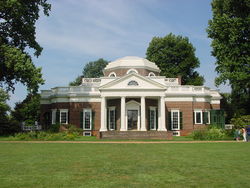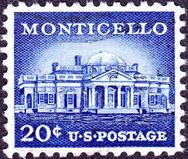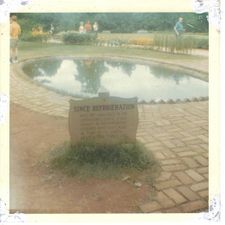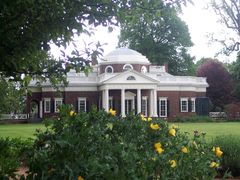Monticello
| Monticello | |
 Monticello
|
|
| Location: | Albemarle County, near Charlottesville, Virginia, USA |
| Coordinates: | |
| Built: | 1772 |
| Architect: | Thomas Jefferson |
| Architectural style(s): | Neoclassical |
| Governing body: | The Thomas Jefferson Foundation |
| UNESCO World Heritage Site | |
| Official name: Monticello and the University of Virginia in Charlottesville | |
| Type: | Cultural |
| Criteria: | i, iv, vi |
| Designated: | 1987 (11th session) |
| Reference #: | 442 |
| Region: | Europe and North America |
| U.S. National Register of Historic Places | |
| Designated: | October 15, 1966[1] |
| Reference #: | 66000826 |
| U.S. National Historic Landmark | |
| Designated: | December 19, 1960[2] |
 Location of Monticello in Virginia
|
|

Monticello (pronounced /mɒntɨˈtʃɛloʊ/) is a historical site just outside Charlottesville, Virginia, United States. It was the estate of Thomas Jefferson, the principal author of the United States Declaration of Independence, third President of the United States, and founder of the University of Virginia.
The house, which Jefferson himself designed, was based on the neoclassical principles described in the books of the Italian Renaissance architect Andrea Palladio. It is situated on the summit of an 850-foot (260 m)-high peak in the Southwest Mountains south of the Rivanna Gap. Its name comes from the Italian "little mountain."
An image of the west front of Monticello by Felix Schlag has been featured on the reverse of the nickel minted since 1938 (with a brief interruption in 2004 and 2005, when designs of the Westward Journey series appeared instead).
Monticello also appeared on the reverse of the two-dollar bill from 1928 to 1966, when the bill was discontinued. The current bill was introduced in 1976 and retains Jefferson's portrait on the obverse but replaced Monticello on the reverse with an engraved modified reproduction of John Trumbull's painting Declaration of Independence instead. The gift shop at Monticello hands out two-dollar bills as change.
Monticello, along with the nearby University of Virginia, was designated a UNESCO World Heritage Site in 1987.
Contents |
History
Work began on what historians would subsequently refer to as "the first Monticello" in 1768. Jefferson moved into the South Pavilion (an outbuilding) in 1770. Jefferson left Monticello in 1784 to serve as Minister of the United States to France. During his tenure in Europe, he had an opportunity to see some of the classical buildings with which he had become acquainted from his reading, as well as to discover the "modern" trends in French architecture that were then fashionable in Paris. His decision to remodel his own home may date from this period. In 1794, following his service as the first U.S. Secretary of State (1790–93), Jefferson began rebuilding his house based on the ideas he had acquired in Europe. The remodeling continued throughout most of his presidency (1801–09).
Thomas Jefferson added a center hallway and a parallel set of rooms to the structure, more than doubling its area. He removed the second full-height story from the original house and replaced it with a mezzanine bedroom floor. The most dramatic element of the new design was an octagonal dome, which he placed above the West front of the building in place of a second-story portico. The room inside the dome was described by a visitor as "a noble and beautiful apartment," but it was rarely used—perhaps because it was hot in summer and cold in winter, or because it could only be reached by climbing a steep and very narrow flight of stairs. The dome room has now been restored to its appearance during Jefferson's lifetime, with "Mars yellow" walls and a painted green floor.[4]
Thomas Jefferson died on July 4, 1826, and Monticello was inherited by his eldest daughter Martha Jefferson Randolph. Financial difficulties led to Martha selling Monticello to James T. Barclay, a local apothecary, in 1831. Barclay sold it in 1834 to Uriah P. Levy, the first Jewish American to serve an entire career as a commissioned officer in the United States Navy. Levy greatly admired Jefferson. During the American Civil War, the house was seized by the Confederate government and sold, though Uriah Levy's estate recovered it after the war.
Lawsuits filed by Levy's heirs were settled in 1879, when Uriah Levy's nephew, Jefferson Monroe Levy, a prominent New York lawyer, real estate and stock speculator and member of Congress, bought out the other heirs and took control of the property. Jefferson Levy, like his uncle, repaired, restored and preserved Monticello, which was deteriorating seriously while the lawsuits wended their way through the courts in New York and Virginia.
A private non-profit organization, the Thomas Jefferson Foundation, purchased the house from Jefferson Levy in 1923 with funds raised by Theodore Fred Kuper and it was restored by architects including Fiske Kimball and Milton L. Grigg.[5] Monticello is now operated as a museum and educational institution. Visitors can view rooms in the cellar and ground floor, but the second and third floors are not open to the general public due to fire code restrictions. Visitors can, however, tour the third floor (Dome), while on a Signature Tour.[6]
Monticello is the only private home in the United States that has been designated a World Heritage Site. From 1989 to 1992, a team of architects from the Historic American Buildings Survey (HABS) painstakingly created a collection of measured drawings of Monticello. These drawings are now kept at the Library of Congress. The World Heritage Site designation also includes the original grounds of Jefferson's University of Virginia.
Among Jefferson's other designs are his other home near Lynchburg called Poplar Forest and the Virginia State Capitol in Richmond.
Decoration and furnishings

Much of Monticello's interior decoration reflect the ideas and ideals of Jefferson himself.[7]
The original main entrance is through the portico on the east front. The ceiling of this portico incorporates a wind plate connected to a weather vane, showing the direction of the wind. A large clock face on the external east-facing wall has only an hour hand since Jefferson thought this was accurate enough for outdoor laborers.[8] The clock reflects the time shown on the "Great Clock", designed by Jefferson, in the entrance hall. The entrance hall contains recreations of items collected by Lewis and Clark on their famous expedition. The floorcloth here is painted a "true grass green" upon the recommendation of artist Gilbert Stuart in order for Jefferson's 'essay in architecture' to invite the spirit of the outdoors into the house.
The south wing includes Jefferson's private suite of rooms. The library holds many books in Jefferson's third library collection. His first library was burned in a plantation fire, and he 'ceded' (or sold) his second library in 1815 to the United States Congress to replace the books lost when the British burned the Capitol in 1814.[9] This second library formed the nucleus of the Library of Congress.[9] As famous and "larger than life" as Monticello seems, the house itself has approximately 11,000 square feet (1,000 m2) of living space.[10] Jefferson considered much furniture to be a waste of space, so the dining room table was erected only at mealtimes, and beds were built into alcoves cut into thick walls that contain storage space. Jefferson's bed opens to two sides: to his cabinet (study) and to his bedroom (dressing room).[11]

The west front (illustration) gives the impression of a villa of very modest proportions, with a lower floor disguised in the hillside.
The north wing includes the dining room—which has a dumbwaiter incorporated into the fireplace as well as dumbwaiters (shelved tables on castors) and a pivoting serving door with shelves—and two guest bedrooms.
Outbuildings and plantation
The main house was augmented by small outlying pavilions to the north and south. A row of functional buildings (dairy, wash houses, store houses, a small nail factory, a joinery etc.) and slave dwellings known as Mulberry Row lay nearby to the south. A stone weaver's cottage survives, as does the tall chimney of the joinery, and the foundations of other buildings. A cabin on Mulberry Row was, for a time, the home of Sally Hemings; she later moved into a room in the "south dependency" below the main house. On the slope below Mulberry Row Jefferson maintained an extensive vegetable garden.
The house was the center of a plantation of 5,000 acres (2,000 ha) tended by some 150 slaves. There are also two houses included in the whole.
In 2004, the trustees acquired the only property that overlooks Monticello, the taller mountain that Jefferson called Montalto, but known to Charlottesville residents as Mountaintop Farm, Patterson's or Brown's Mountain. Rushing to stave off development of new homes, the trustees spent $15 million to purchase the property, which Jefferson had owned and which had served as a 20th-century residence as farm houses divided into apartments for many University of Virginia students (including George Allen). The officials at Monticello had long viewed the property located on the mountain as an eyesore, and were very interested in purchasing the property when it came on the market.[12] Monticello now charges $20 for adults and $7 for children to visit the top of the mountain and only allows admission to the area from May to October.[13]
Architecture
The house is very similar in appearance to Chiswick House, another Neo-Palladian house built in 1726-9 in London.

Monticello was featured in Bob Vila's A&E Network production, Guide to Historic Homes of America,[14] in a tour which included the Dome Room, which is only open to the public during a limited number of tours each year, and Honeymoon Cottage.
Sidney Fiske Kimball, father of the University of Virginia's School of Architecture, and one of the prime movers behind the restoration of Monticello, and author of the book Thomas Jefferson, Architect, used Jefferson's architectural principles to build his own retirement home outside Charlottesville called "Shack Mountain," short for Shackelford Mountain, the surname of a branch of Jefferson's descendants. Built in 1935-1936, Shack Mountain is a Jefferson-style pavilion, like Monticello, that is considered Kimball's masterpiece.[15][16] Kimball himself advised on the restoration of Colonial Williamsburg and Stratford Hall Plantation. Shack Mountain was nominated as a National Historic Landmark in 1992.[17]
Replicas
The entrance pavilion of the Naval Academy Jewish Chapel at Annapolis is modeled on Monticello.
Panoramas


See also
- Jeffersonian architecture
- Monticello Association
- Poplar Forest, Jefferson's private retreat.
References
- ↑ "National Register Information System". National Register of Historic Places. National Park Service. 2006-03-15. http://www.nr.nps.gov/.
- ↑ "Monticello (Thomas Jefferson House)". National Historic Landmark summary listing. National Park Service. http://tps.cr.nps.gov/nhl/detail.cfm?ResourceId=632&ResourceType=Building. Retrieved 2008-06-27.
- ↑ Scotts U.S. Stamp Catalogue
- ↑ Kern, Chris. "Jefferson's Dome at Monticello". http://www.ChrisKern.Net/essay/jeffersonsDomeAtMonticello.html. Retrieved 2009-07-10.
- ↑ Fleming, Thomas. "The Jew Who Helped Save Monticello." The Jewish Digest. February 1974: 43-49.
- ↑ "Evening Signature Tours". Monticello. http://www.monticello.org/visit/signature_tours.html. Retrieved 2010-07-09.
- ↑ "A Day in the Life of Thomas Jefferson: Sunrise Design and Decor". Monticello.org. http://www.monticello.org/jefferson/dayinlife/sunrise/design.html. Retrieved 2010-07-09.
- ↑ "A Day in the Life of Thomas Jefferson: Entrance Hall - Design and Decor". Monticello.org. http://www.monticello.org/jefferson/dayinlife/entrance/design.html. Retrieved 2010-07-09.
- ↑ 9.0 9.1 "History - About the Library (Library of Congress)". Loc.gov. 1987-09-14. http://www.loc.gov/about/history.html. Retrieved 2010-07-09.
- ↑ The House FAQ - Monticello website
- ↑ "Jefferson's Alcove Bed". Monticello.org. http://www.monticello.org/jefferson/dayinlife/sunrise/bedroom.html. Retrieved 2010-07-09.
- ↑ "The Hook - Off Montalto, "It's all downhill from here."". 2004-06-03. http://www.readthehook.com/Stories/2004/06/03/newsOffMontaltoquotitsAllD.html.
- ↑ "Jeffersons's Monticello: Getting Tickets". 2007-02-17. http://www.monticello.org/visit/getting_tickets.html.
- ↑ Bob Vila (1996). ""Guide to Historic Homes of America."". A&E Network. http://www.bobvila.com/BVTV/AE/America.html.
- ↑ The Virginia Landmarks Register, By Calder Loth, Virginia Department of Historic Resources, Published by University of Virginia Press, 1999, ISBN 0-8139-1862-6
- ↑ The Architecture of Jefferson Country: Charlottesville and Albemarle County, K. Edward Lay, University of Virginia Press, 2000
- ↑ Fiske Kimball, Shack Mountain, University of Virginia library, lib.virginia.edu
External links
- Thomas Jefferson's Monticello, official site
- Monticello's Shadows, City Journal, Autumn 2007
- World Heritage Nomination
- The Monticello Explorer, an interactive multimedia look at the house
- Thomas Jefferson Wiki
- HABS drawing
- Monticello Association of Jefferson lineal descendants
- "Moving a mountain: How Monticello got Montalto back" — article in The Hook
- Monticello restoration and Milton Grigg
- Tour Experience of Monticello
- Jefferson's Dome at Monticello
- A photographic collection of Thomas Jefferson's architecture
|
|||||||||||||||||||||||
|
||||||||||